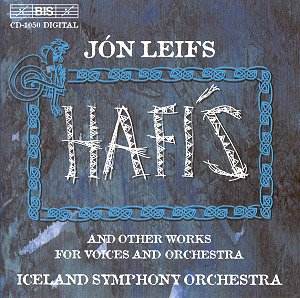Jón LEIFS (1899 -
1968)
Hafís, Tveir Söngvar, Guðrúnarkviða, Nótt,
Fine 1
Iceland Symphony Orchestra
Schola Cantorum
Ingveldur Yr Jónsdóttir, Gunnar Guðbjörnsson, Ólafur
Kjartan Sigurðarson, Loftur Erlingsson
Conducted by Anne Manson
BIS CD-1050
[55.41]
Crotchet

This latest CD in the BIS Jón Leifs series demonstrates, if such were
needed, that news of the demise of the classical recording industry is wildly
exaggerated. As long as record companies continue to research the archives
for hidden masterpieces - and 'masterpieces' is no exaggeration for the music
to be found on this disc - and serves them up with such loving care and attention
as BIS has done here, then there is plenty of hope for the future of the
medium, whether it be in the form of downloads or physical music carriers.
For those new to Leifs, a brief introduction is called for. Born in Iceland
in 1899, he became an avid reader at an early age, particularly the Sagas
and other Old Icelandic poetry. As a patriot he was moved by poetic descriptions
of Iceland's struggle to free itself from Danish domination. As a romantic
he was deeply affected by descriptions of Iceland's dramatic Nordic landscape.
Both strands appear regularly in his vocal works and his musical style is
strongly descriptive and pictorial. The quality of the music, however, is
never subjugated by the subject matter and Leifs' voice is unquestionably
his own. Rarely did I find myself reminded of other composers when listening
to this CD.
The CD is entitled Hafís (Drift Ice) which, at 17.49, is the
longest work featured here and was composed shortly before Leifs' death.
The text is from the late romantic poet Einar Benediktsson (1864 - 1940)
and falls very much into the 'landscape-poem' variety. The choral part is
tortuous in the extreme with many wide leaps at pianissimo. This perhaps
explains why it was not performed until 1999, in preparation for this recording.
A succession of slow passages leading to ferocious climaxes occur one after
the other, each more dramatic than the last, until the words 'bursting blockades
of waters dashing' are reached and the music subsides into a final release
of calm.
The earliest work, the relatively well-known Lullaby, for mezzo and
orchestra shows how consistent Leifs' style remained throughout his composing
career. His music is almost always underpinned by use of the bass instruments
- tympani (which dominate in Hafis), cellos and basses, bassoons,
trombones and the low percussion. Above, the strings and higher wind ebb
and flow with wide rhythmic variety and subtle use of colour and timbre.
This is particularly effective in Lullaby where the words 'Everywhere
silence flows, Sun slips into the sea' are accompanied by a magical liquidity
of texture.
The Lay of Gudrun falls into the historical/political category. Leifs
chose his texts from Eddic poetry as his personal reaction to the potential
occupation of Iceland by Germany in 1940, when Denmark and Norway had already
fallen. The poem describes Gudrun's stoic grief at the death of her husband
at the hands of her own brothers. Only when her companions tell of their
own griefs can Gudrun break down and make a passionate homage to her husband
and demonstrate her anger at what might have been. As an allegory of the
fears felt by the Nordic peoples and the moral issues raised by questions
of resistance, Leifs' warning in music could hardly have been more apposite.
The music is suitably dark - a truly intense eleven minutes. The three soloists
sing magnificently.
Night makes use of the old Icelandic form of singing in fifths and
the meeting of two lovers at night is calmly described by the tenor and baritone
in this rather ancient form. But Leifs has a trick up his sleeve and the
musical description (for orchestra alone) of the consummation of the lovers
comes entirely unexpectedly, with a passionate climax (including flutter
tongued flutes) which is genuinely moving.
Leifs had planned a trilogy of Edda oratorios - by far his most ambitious
project - but after the first was finished he realised that he might never
be able to complete all three parts. In 1963 he wrote two short orchestral
works, Fine 1 and 2 which would provide an acceptable conclusion
should he die 'with a work unfinished - even in mid-bar'. Fine 1 is
an angry, fist-shaking and abrasive work of great power with powerful use,
again, of low brass and tympani. This twelve-minute masterpiece could hardly
conclude a CD of such importance without leaving a slightly lopsided view
of Leifs the man, however brilliant the music. BIS has wisely repeated the
short Lullaby at the very end.
The Iceland Symphony Orchestra performs superbly under the excellent Anne
Manson. (Yet another fine female conductor here makes a further strong case
for a major international orchestra to employ a woman as Music Director).
The recording is beautifully achieved and there are first-class notes and
translations.
Simon Foster
Performance

Sound


